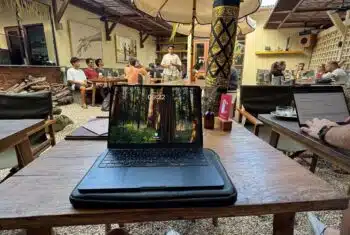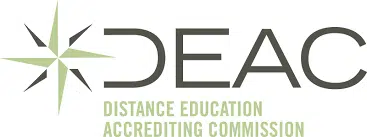Digital Nomad Language Learning: The Best Ways To Learn A Language While Travelling
Join a global community of over 200,000 TEFL teachers working throughout the world! Enrol me!
Picture this: you’re sipping a café con leche in a Barcelona cafe, firing off work emails, and then practising your Spanish with the barista – all in the same morning.
That right there is the big appeal of the digital nomad lifestyle: the opportunity to work from anywhere in the world whilst immersing yourself in new cultures.
For many travellers, this freedom opens up an incredible opportunity for digital nomad language learning. But, as exciting as this may sound, learning a new language whilst grappling with a load of impending deadlines, client calls, and travel plans isn’t always easy.
But when you can juggle remote work with the right strategies for langauge learning, being a digital nomad can really accelerate your progress and provide you with a more genuine way to connect with people across the world.
Read more: The Digital Nomad Visa: A Ticket To Your Best Life
Why digital nomads are perfectly placed to learn a language
Perhaps the biggest plus of opting to learn a language as a digital nomad is that you’re constantly surrounded by opportunities to put your skills to the test. Unlike classroom studies back home, you’re living and working in an environment where the language is spoken every day by everyone.
From ordering food, navigating transport, to chatting with your students, all of it is a part of your language learning journey. This sort of immersion is a powerful tool for any digital nomad – because the culture itself becomes your mentor.
Read more: Immersion Learning Explained
Being a digital nomad is all about being free. This lack of a fixed schedule is a huge plus for learning a language. Instead of brushing up on your vocabulary during your 9-5 lunch hour, you can mould your day to include practice lessons or sessions with a language exchange partner. Even going to your local grocery store can be a way to brush up on your language!
Through this mix of flexibility and consistent exposure, nomads are poised to make faster, more meaningful progress.
Challenges of learning a language while living the digital nomad life
Let’s be real here: life on the road isn’t without its hurdles – particularly when it comes to language learning. Constant travel can make it hard to stick to a study routine. One week, you could be kicking back in a co-working space with reliable wifi; the next, you’re hopping between buses or trains with no time to go over your vocabulary.
This lack of consistency can really slow your progress if you’re not careful.
Another potential hurdle is knowing how to manage your time. Remote work demands don’t stop just because you want to brush up on your Spanish or squeeze in a conversation exchange. Balancing deadlines with study sessions takes discipline and planning.
Finally, another big challenge of being a digital nomad is loneliness, especially in new cities where they don’t have much of a social circle yet. Whilst this can be an isolating experience, it also highlights the value of learning the local language – it’s the quickest, easiest way to build connections.
So, can you learn new languages as a digital nomad? Absolutely! But it requires more intention and structure than the average language-learning journey.
Read more: How Adults Learn Foreign Languages
The best strategies for digital nomad language learning
There are a number of ways to guarantee steady progress when learning a language. By blending immersion with practical tools, you can turn everyday experiences into handy opportunities for learning. Here are our favourite learning tips for digital nomads.
Use immersion to your advantage
When you live abroad, the entire world becomes your classroom. Take the time to speak the local language in your everyday life, from ordering food, asking directions, to chatting at a local market.
Local activities such as cooking classes or sports clubs are fun ways of being immersed in both a language and a culture. These real-life experiences help make vocabulary stick faster than just relying on your flashcards.
Join digital nomad & language exchange communities
Coworking areas. Nomad hubs. Language exchange meetups. There are so many great places to put your language skills into practice. They don’t just give you accountability, they allow you to connect with locals and other travellers who are also looking to practice. Learning is easier when it’s social.
Utilise tech
Digital tools can bridge the gaps when travelling upends your routine. Popular apps for digital nomads to learn languages are easy to use on the go. Our favourites? Duolingo, Babbel, and Memrise. Couple them with online tutors on platforms like iTalki, Cambly, or Preply, and you’ll always have access to structured learning, wherever you go.
Read more: Online Teaching Platforms You Need To Know
Create a routine that fits remote work
Consistency is king, not intensity. Try to carve out short, focused study sessions that fit around your workload – 20 minutes before emails, or vocab practice during your lunch break. By coupling study to your routine, you’ll make language learning a sustainable part of your nomadic lifestyle.
Take advantage of your classroom
As digital nomads who are TEFL teachers, don’t forget about your classroom. Classrooms are an opportunity to hear your students and other teachers speak their first language. The more you hear the language in context, the more likely you are to pick it up. It’s especially helpful for pronunciation.
The TEFL Academy Staff Writer Lauren taught English in South Korea for two years. She says:
When the teacher gave the class an instruction, I would notice what the students were doing in response. From there, I would figure out the meaning.
For example, I would often hear words like anja, after which they would sit down, and sikkeureo (usually with a raised voice by a frustrated teacher), which means to be quiet.
Sometimes I would ask a teacher about a particular word I had heard earlier in the day, and I also learnt Korean this way.
Best destinations for digital nomads to learn a language
Some countries make it easier than others to juggle remote work setups with immersive learning opportunities. Consistent wifi, affordable costs of living, and vibrant communities are key for nomads who want to pick up a new language whilst travelling. Here are some of our favourite cities for digital nomads to learn a language:
Read more: How To Learn The Local Language
Spain or Latin America (Spanish)
Spanish is the second-most spoken language in the world and one of the most practical languages to learn. There are so many digital nomad hubs to choose from. Barcelona, Madrid, and Valencia in Spain offer bustling coworking communities alongside endless chances to practice Spanish every day.
For lower costs of living, cities like Medellín in Colombia or Oaxaca in Mexico are among the best destinations to learn Spanish as a digital nomad, blending affordable lifestyles with welcoming, colourful communities.
Japan (Japanese)
Tokyo and Osaka are lively hubs with incredible infrastructure, making them attractive for digital nomads. Japan offers exceptional cultural immersion, where learning even the most basic Japanese phrases can greatly enrich your day-to-day experiences.
Smaller cities such as Fukuoka are increasingly popular among nomads on the back of lower costs and an ever-expanding expat community.
France (French)
Paris might be iconic, but, smaller cities like Lyon, Toulouse, or Montpellier usually provide a more affordable and authentic immersive experience. With vibrant student populations and solid transport links, these cities give digital nomads both modern amenities and plenty of opportunities to flex their French outside of the classroom.
Balancing work and language learning as a digital nomad
One of the trickiest parts of life on the road is balancing professional responsibilities with personal aims. For many nomads, juggling work and language learning whilst travelling can be overwhelming – however, with the right approach, it’s totally manageable!
Start off by weaving language study into your workday the same way you would schedule client calls or meetings. Carve out small sessions for practice, whether it’s a quick grammar review during breakfast or a conversation class after dinner. As we said earlier, consistency is king.
There’s also a chance to take advantage of any “dead time” in your schedules. Travel days, lunch hours, or even your commutes around town are great opportunities to listen to conversations, review flashcards, or practice pronunciation.
And talk to locals at every opportunity!
These small, steady efforts build up over time. By making language learning a part of your day, you’ll find yourself staying productive at work and making meaningful progress towards fluency.
So there you have it, everything you need to know about digital nomad language learning. If you’ve ever dreamed of combining work, travel, and cultural connection, teaching English overseas or online is one of the best places to dive into a digital nomad lifestyle.
If you want to become a digital nomad and improve your language skills, the best place to start is by getting a TEFL certificate with The TEFL Academy. It could be your first step toward fluency – and a life of freedom!
Accreditation & Quality Assurance
The TEFL Academy was the world’s first TEFL course provider to receive official recognition from government regulated awarding bodies in both the USA and UK. This means when you graduate you’ll hold a globally recognised Level 3 (120hr) Certificate or Level 5 (168hr) Diploma, meaning you can find work anywhere and apply for jobs immediately.
 United States
US
United States
US





















